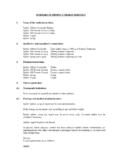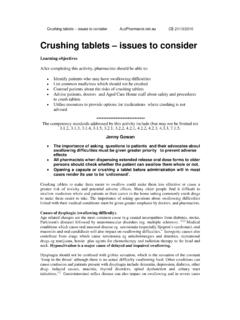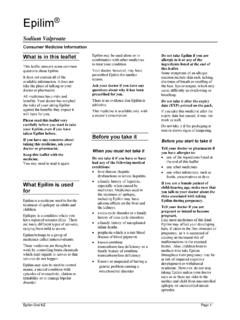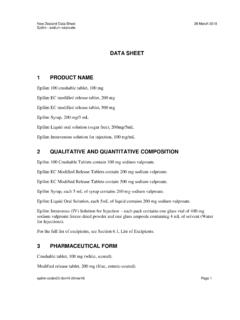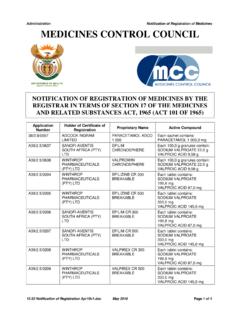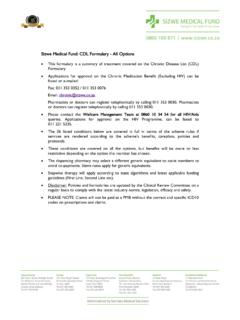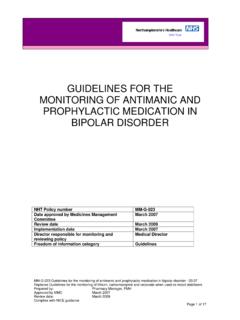Transcription of SCHEDULING STATUS: S3 PROPRIETARY NAME …
1 1. SCHEDULING status : S3. PROPRIETARY name (and dosage form): epilim Liquid Sugar-free (Liquid). epilim CR 200 (Prolonged Release tablets ). epilim CR 300 (Prolonged Release tablets ). epilim CR 500 (Prolonged Release tablets ). epilim 100 Crushable ( tablets ). epilim Intravenous (Freeze-dried powder for intravenous injection). with Water for Injection epilim (Solvent ampoule). COMPOSITION: 1. epilim Liquid Sugar-free: each 5 ml contains 200 mg Sodium Valproate Preservatives: Sodium Methylparabenzoate 0,1 % m/v and Sodium Propylparabenzoate 0,04 % m/v. 2. epilim CR 200: each tablet contains 133,2 mg sodium valproate and 58,0 mg valproic acid equivalent to 200 mg sodium valproate.
2 3. epilim CR 300: each tablet contains 199,8 mg sodium valproate and 87,0 mg valproic acid equivalent to 300 mg Sodium Valproate. 4. epilim CR 500: each tablet contains 333,0 mg sodium valproate and 145,0 mg valproic acid equivalent to 500 mg sodium valproate. 5. epilim 100 Crushable: each tablet contains 100 mg Sodium Valproate. 6. epilim Intravenous: each vial contains 400 mg freeze-dried sodium valproate, with Water for Injection - epilim : each ampoule contains 4 ml sterile water for injection. PHARMACOLOGICAL CLASSIFICATION: A Anticonvulsants, including anti-epileptics. 2. PHARMACOLOGICAL ACTION: Pharmacodynamic properties: Sodium valproate has anticonvulsant properties.
3 The exact mode of action is unknown. However, the most likely mode of action for valproate is potentiation of the inhibitory action of gamma amino butyric acid (GABA) through an action on the further synthesis or further metabolism of GABA. Pharmacokinetic properties: Peak plasma concentrations are observed in 1 to 4 hours after sodium valproate liquid, but this can be delayed for several hours if valproic acid is administered in enteric-coated tablets , in prolonged release formulation, or is ingested with meals. Sodium valproate bioavailability is close to 100 % following oral or IV administration. Valproic acid concentration in cerebrospinal fluid is close to free plasma concentration.
4 Steady state plasma concentration is reached after 3 to 4 days, following oral administration. Valproate is highly bound to plasma proteins; protein binding is dose dependent and saturable. When given in therapeutic doses, most of the medicine is converted to the conjugate ester of glucuronic acid, while mitochondrial metabolism, principally by means of beta-oxidation, accounts for the remainder. Some of the metabolites have anticonvulsant activity. Sodium valproate is mainly excreted in urine following metabolism via glucuro-conjugation and beta-oxidation. Sodium valproate does not increase its own degradation, neither that of other agents such as oestrogen and progestogen containing medicines.
5 The elimination half-life of sodium valproate varies from approximately 8 to 20 hours. It is usually shorter in children. In patients with severe renal insufficiency it may be necessary to alter dosage in accordance with free plasma valproic acid levels. The reported effective therapeutic range for plasma valproic acid levels in epilepsy is considered to be between 30 and 100 g/ml. This reported range may depend on time of sampling and 3. presence of co-medication. The percentage of free (unbound) drug is usually between 6 % and 15 % of total plasma levels. The pharmacological (or therapeutic) effects of epilim are not clearly correlated with the total or free (unbound) plasma valproic acid levels.
6 In cases where measurement of plasma levels is considered necessary, trough plasma levels should be used for therapeutic monitoring. INDICATIONS: In the treatment of generalised epilepsy, particularly with the following patterns of seizures: absence myoclonic tonic-clonic atonic mixed as well as, for partial epilepsy: simple or complex seizures secondary generalised seizures specific syndromes (West, Lennox-Gastaut). epilim CR: for the treatment and prevention of mania associated with bipolar disorders. epilim Intravenous is indicated in patients for whom oral therapy is temporarily not possible. CONTRA-INDICATIONS: Hypersensitivity to sodium valproate.
7 Use of epilim in pregnancy should be avoided (see Pregnancy and Lactation ). Active liver disease, including the following: o Acute hepatitis. o Chronic hepatitis. o Personal or family history of hepatic dysfunction especially drug related. o Hepatic porphyria. 4. WARNINGS: Liver dysfunction: Conditions of occurrence: Cases of severe liver damage resulting sometimes in fatalities have been reported. Experience in epilepsy has indicated that patients most at risk especially in cases of multiple anticonvulsant therapy are infants and young children under the age of 3 with severe seizure disorders, particularly those with brain damage, mental retardation and (or) congenital metabolic or degenerative disease.
8 After the age of 3, the incidence of occurrence is reduced and decreases with age. In most cases, such liver damage occurred during the first 6 months of therapy. Suggestive signs: Clinical symptoms are essential for early diagnosis. In particular, the following conditions, which may precede jaundice, should be taken into consideration, especially in patients at risk (see above Conditions of occurrence ): - non-specific symptoms, usually of sudden onset, such as asthenia, anorexia, lethargy, drowsiness, which are sometimes associated with repeated vomiting and abdominal pain. - in patients with epilepsy, recurrence of seizures. Patients (or their family for children) should be instructed to report immediately any such signs to a physician should they occur.
9 Investigations including clinical examination and biological assessment of liver function should be undertaken immediately. Detection: Liver function should be performed before and then periodically monitored during the first 6 months of therapy. Amongst usual investigations, tests which reflect protein synthesis, particularly prothrombin rate, are most relevant. Confirmation of an abnormally low prothrombin rate, particularly in association with other biological abnormalities (significant decrease in fibrinogen and coagulation factors; increased bilirubin level and raised transaminases) requires cessation of epilim therapy. As a matter of precaution and in case they are taken concomitantly salicylates should also be discontinued since they employ the same metabolic pathway.
10 5. Pancreatitis: Severe pancreatitis, which may result in fatalities, has been rarely reported. Young children are at particular risk. This risk decreased with increasing age. Severe seizures, neurological impairment or anticonvulsant therapy may be risk factors. Hepatic failure with pancreatitis increases the risk of fatal outcome. INTERACTIONS: Effects of epilim on other medicines: - Neuroleptics, MAO inhibitors, antidepressants and benzodiazepines epilim may potentiate the effect of other psychotropics such as neuroleptics, MAO inhibitors, antidepressants and benzodiazepines; therefore clinical monitoring is advised and dosage should be adjusted when appropriate.
